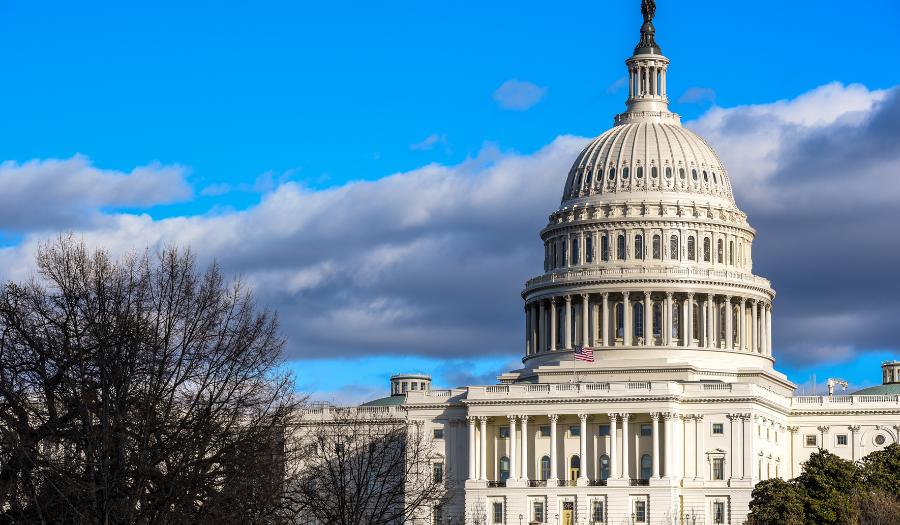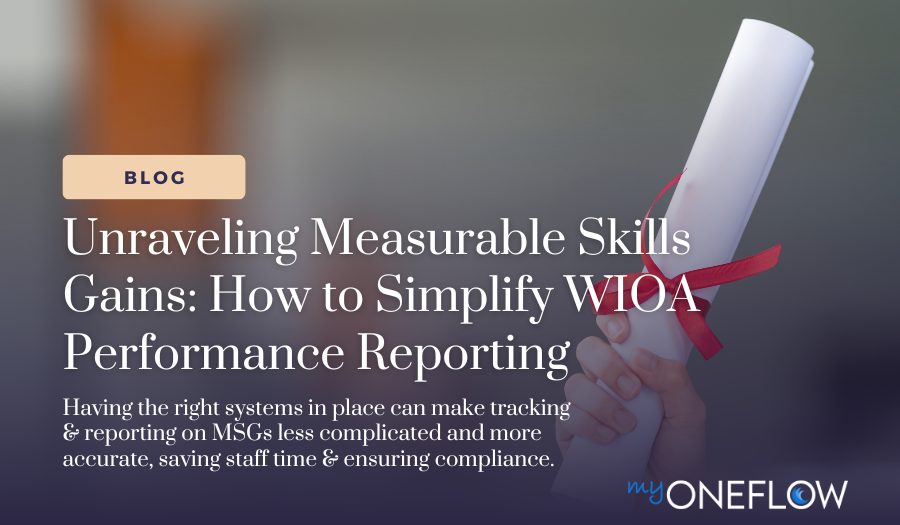Unraveling Measurable Skills Gains: How to Simplify WIOA Performance Reporting
Measurable Skills Gains (MSGs) are a fundamental aspect of evaluating participant progression in WIOA-funded programs and constitute a significant...

This post was last updated on August 25, 2025. To stay informed on future updates, please subscribe to the newsletter.
The Workforce Innovation and Opportunity Act (WIOA), enacted in 2014, remains a pivotal yet overdue piece of workforce legislation. Since its expiration in 2020, significant efforts have been made to modernize and reauthorize WIOA, yet we've seen consistent delays in delivering updates that meet today's labor and economic challenges.
Efforts gained traction in late 2024 with the A Stronger Workforce for America Act (H.R. 6655), which included bold proposals to reshape workforce development, including targeted funding mandates and strengthened employer partnerships. Despite bipartisan support, the bill failed to pass, leaving WIOA reauthorization in limbo.
Discussions have continued into 2025, but disagreements over key elements, such as allocations for training and program flexibility, continue to hold up progress. This tension has intensified with a new administration that has introduced sweeping changes to the structure and funding of workforce programs, while Congress passed a major reconciliation bill that fundamentally reshapes federal support for workforce development and basic needs programs.
Earlier this summer, Congress enacted the large-scale “One Bill” reconciliation package, which implemented substantial reductions to several federal programs supporting basic needs, including food assistance, housing, health care, and education access. While the legislation expands Pell Grant eligibility to students enrolled in certain short-term postsecondary programs, most other changes involve tightened funding or eligibility for various supports.
Some advocacy organizations and policy experts have raised concerns that this mix of changes may have negative effects on workers and families. For example, estimates indicate that new work reporting requirements for Medicaid could result in between 9.9 and 14.9 million individuals losing coverage by 2034. The bill also marks the first time in recent history that the federal government will not fully cover the cost of food assistance benefits for low-income families, including student parents and trainees, shifting a portion of these costs to states.
Such changes are expected to create additional pressures on state budgets, requiring state leaders to consider options such as reducing their support for basic needs, reallocating education and training funds, or potentially raising taxes.
One of the most significant shifts outlined in President Trump's FY26 budget proposal is the creation of the Make America Skilled Again (MASA) block grant program. This proposal consolidates various federal workforce initiatives into a single funding pool, aiming to simplify how states manage workforce investments.
Consolidation of Workforce Programs:
MASA would replace specific WIOA Titles as well as special funding for programs such as:
Budget and Allocation Details:
Funded at just under $3 billion, MASA grants would be distributed to states by formula. A minimum of 10% of the grant funding would be allocated to registered apprenticeship programs, keeping their funding level steady compared to historical appropriations. To ensure states receive assistance in managing these significant changes, the budget also includes a small national technical assistance pool (0.25% of the total grant).
By consolidating programs into a single funding stream, the administration aims to enhance state-level flexibility and reduce administrative overhead. However, critics argue that this approach risks undercutting specialized programs and failing to meet the needs of vulnerable populations, including migrants and disadvantaged youth.
The Senate Appropriations Committee’s FY26 bill takes a different approach from the administration by opting not to adopt the MASA block grant proposal. Instead, it continues funding workforce programs in separate categories, generally at amounts close to those in the previous year. Notable adjustments include a reduction of about $10 million (around 1%) for the WIOA Adult program, a decrease of roughly $5 million (just over 4%) for Reentry Employment Opportunities, and a $10 million reduction for the Senior Community Service Employment Program, which still remains operational.
The Women’s Bureau is also preserved in the Senate bill, receiving $23 million in total funding, with at least $5 million set aside for grants aimed at advancing women in apprenticeship and nontraditional fields—contrasting with proposals that suggested ending the bureau entirely.
While these funding choices help avoid the deeper cuts suggested in other proposals, some policy experts and organizations note ongoing concerns about whether available resources will be enough to meet the needs of job seekers and workforce programs given current demand and cost pressures.
The administration's original budget called for dramatic reductions in workforce investments:
The Senate bill prevents the worst of these cuts but still falls short of providing robust investments the workforce system needs. For Adult Education specifically, the Senate proposes $729.1 million, representing a modest increase of $13.7 million over FY24 levels and explicitly rejecting the administration's elimination proposal.
The sequence of events surrounding Job Corps has grown more complicated following the Department of Labor’s announcement on May 29, 2025, that all contractor-operated Job Corps centers would begin pausing operations by June 30. The agency cited a range of issues—financial shortfalls, including an anticipated $213 million deficit for program year 2025, as well as ongoing concerns about center performance and safety—as factors in its decision to halt activities.
In response, the National Job Corps Association brought a legal challenge against the Department of Labor’s decision, claiming it would unlawfully disrupt vital services for at-risk youth. In June 2025, a federal judge issued a preliminary injunction that temporarily blocks the center closures, allowing Job Corps sites to continue operating as the lawsuit moves forward.
Current Status:
This legal standoff has sparked bipartisan opposition from lawmakers, including Senator Susan Collins and Senator Tammy Baldwin, who have criticized the closure attempt for potentially worsening labor shortages and eliminating critical opportunities for underserved communities.
Despite the broader budget battles, bipartisan interest in WIOA reform persists. Hearings earlier in the year in the House and Senate highlighted a shared desire to improve WIOA and address challenges in connecting job seekers with available opportunities. The Stronger Workforce for America Act remains a focal point, promoting provisions to:
Congress has also expressed strong interest in improving workforce data collection systems, which would allow states to better align training programs with labor market needs.
When Congress returns from August recess, they will have less than a month to pass a full-year spending bill, reach agreement on a continuing resolution, or risk a government shutdown beginning October 1st. The House is expected to propose more significant cuts than the Senate, setting up negotiations that will determine final funding levels for workforce programs.
Federal agencies are beginning to implement the reconciliation bill's provisions, with some having tight timelines that will take effect before the end of the calendar year. The workforce development community must act quickly to influence how these provisions are rolled out and to minimize harm to workers and families.
The administration’s ongoing commitment to scaling registered apprenticeship programs is promising, reflecting bipartisan support for work-based learning models. While MASA maintains a required 10% allocation for apprenticeship-related activities, overall funding constraints may challenge broader expansion goals. Effective partnerships between employers, schools, and workforce boards will be vital.
The tension between the administration's MASA proposal and Congressional resistance will continue to shape workforce funding discussions. Stakeholders should monitor how this debate influences both appropriations decisions and potential WIOA reauthorization language. While debates over potential funding cuts continue, workforce systems must prepare to address potential service gaps through state-led and community-driven initiatives.
The reconciliation bill's expansion of Pell Grants to short-term programs represents a significant opportunity. Still, states must establish quality frameworks to identify "high-skill, high-wage or in-demand" jobs and invest in workforce data modernization to ensure students have transparent outcomes information.
The workforce development field in 2025 continues to evolve amid a range of legislative, administrative, and legal changes. Recent federal policy actions have introduced new variables for organizations and individuals working in this space. Simultaneously, Congress’s choices to maintain or adjust funding for certain programs are shaping the services available nationwide.
To adapt to these developments, stakeholders can consider the following strategies:
Stay Informed: Monitor ongoing legislative activity at the federal and state levels, as well as any legal proceedings that could affect key programs like Job Corps.
Prepare for Adjustments: Assess the potential implications of changes in funding or program structure, and strengthen partnerships that can help sustain services during transitions.
Prioritize Quality: With expanded eligibility for Pell Grants in short-term programs, establishing systems for quality review and tracking outcomes can contribute to successful results.
Track Effects: Gather and analyze information on how evolving policies and funding levels are impacting job seekers, employers, and communities.
As decisions on WIOA reauthorization are still pending, remaining engaged with policy updates and being prepared to adjust plans as needed can help organizations and leaders continue to deliver workforce services effectively in a shifting environment.
myOneFlow is a modern case management and reporting solution purpose-built for public service providers. Access to better data and streamlined operations can enhance service delivery, improve outcomes, and help you access more diverse funding streams. myOneFlow's configurability helps workforce development agencies adapt to unexpected and ongoing changes in policy and program requirements. Learn more about myOneFlow's features and automation capabilities on our Packages Page.
What is the current status of WIOA reauthorization in 2025?
WIOA reauthorization remains in limbo as Congress navigates broader budget conflicts and reconciliation bill impacts. While bipartisan interest in reforming WIOA persists, the focus has shifted to addressing immediate funding crises and implementation challenges.
What changes for workforce development are included in the FY26 budget proposals?
The administration's budget proposes significant cuts and consolidation through the MASA grant, but the Senate has largely rejected these changes, maintaining distinct funding streams for most workforce programs at current levels.
What's happening with the Job Corps program?
Job Corps centers remain open thanks to a federal court injunction blocking the administration's closure attempt. The program's long-term future depends on ongoing litigation and Congressional appropriations decisions.
How does the reconciliation bill affect workforce development?
The "One Bill" reconciliation package cuts support for basic needs programs that workers rely on, while expanding Pell Grant eligibility for short-term training programs. States now face difficult decisions about filling budget gaps left by federal cuts.
What should stakeholders do amid these changes?
Workforce boards, service providers, and educators should engage in state-level advocacy, monitor federal implementation processes, and prepare contingency plans for funding disruptions while building strategic partnerships to navigate the evolving policy landscape.

Measurable Skills Gains (MSGs) are a fundamental aspect of evaluating participant progression in WIOA-funded programs and constitute a significant...

The U.S. Department of Labor recently released a new Training and Employment Guidance Letter (TEGL), TEGL 03:23, to provide workforce agencies and...

The Workforce Innovation and Opportunity Act (WIOA) was signed into law in 2014 to replace its predecessor, the Workforce Investment Act (WIA). The...